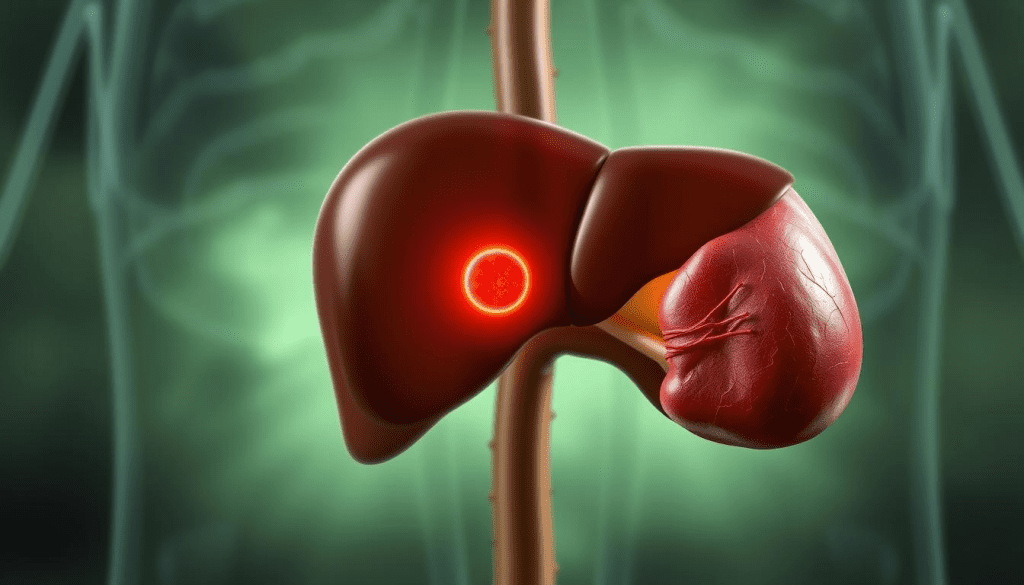Last Updated on October 20, 2025 by
Hepatoblastoma is a rare and serious condition in children. It’s important to know about its diagnosis and treatment. We aim to give accurate and detailed information to help those affected.
Alpha-fetoprotein (AFP) is the main tumor marker for hepatoblastoma. It helps doctors diagnose, track, and predict the outcome of the disease. Hepatic cancer marker like AFP help find and monitor diseases, including hepatoblastoma.

Knowing how AFP works in hepatoblastoma helps us understand the need for accurate diagnosis and treatment. We’re here to support families dealing with this tough condition.
Hepatoblastoma is the most common liver cancer in kids. It brings unique challenges in finding and treating it. We aim to give a full view of this condition, including its commonness in kids and its traits.
This cancer makes up about 80% of liver cancers in children. In the U.S., 50-70 new cases are found each year. The 5-year survival rate for hepatoblastoma has grown, now between 60% and 70%. Early-stage cases have a 90% survival rate.
Knowing about the hepatoma tumor marker and ca liver tumor marker is key in diagnosing and managing hepatoblastoma. These markers help track the disease’s progress and how well it responds to treatment. For more info, check out the National Center for Biotechnology Information.

Hepatoblastoma’s traits can differ, but it’s usually found through imaging and biopsy. Treatment plans depend on the disease’s stage and the patient’s health. We’ll talk more about treatments in later sections.
To wrap up, hepatoblastoma is a complex issue needing a detailed approach for diagnosis and treatment. By grasping its traits and using the right tumor markers, doctors can give kids the best care possible.
Alpha-fetoprotein (AFP) is a key marker for hepatoblastoma, a liver cancer mainly found in kids. It helps doctors see if the disease is there and how it’s growing.
AFP levels go up in more than 90% of cases when hepatoblastoma is first found. This makes it very important for checking if the disease is there and how it’s doing. But, other things can also make AFP levels go up, which can make it less specific.
The sensitivity of AFP means how well it finds people with the disease. Studies show AFP is high in most cases of hepatoblastoma, showing it’s very sensitive. But, its specificity, or how well it finds those without the disease, can be tricky. This is because other conditions can also raise AFP levels.
We use AFP not just to find the disease but also to see how treatment is going and if it comes back. If AFP levels go down, it means the treatment is working. But, if they go up, it might mean the disease is coming back, and we need to check again.

In short, AFP is very important for finding and managing hepatoblastoma. It’s high in over 90% of cases, showing its value. Knowing how sensitive and specific AFP is helps doctors make better choices for their patients.
In some cases, hepatoblastoma doesn’t show high levels of AFP. This makes diagnosing it harder. About 5-10% of cases have normal AFP levels, which means a tougher fight ahead. We’ll look into how this affects diagnosis, treatment, and how patients do.
AFP-negative hepatoblastoma is linked to small cell histology. This makes it tough to diagnose and treat. This subtype needs a detailed diagnostic process for the right treatment. We’ll dive into what’s known about AFP-negative hepatoblastoma and its impact on survival chances.

Diagnosing AFP-negative hepatoblastoma involves imaging and tissue tests. Advanced imaging helps find out the tumor’s size and location. We’ll explain how doctors diagnose this condition.
Treatment for AFP-negative hepatoblastoma is custom-made. It considers the tumor and the patient’s health. Surgery is often key to remove the tumor completely.
Managing AFP-negative hepatoblastoma needs a team effort. Pediatric oncologists, surgeons, and others work together. Understanding this subtype’s challenges helps improve care for these patients.
Getting a correct diagnosis for hepatoblastoma is key. It involves using imaging and tissue tests. These tools help us find out if you have this liver tumor and plan your treatment.
Imaging tests are important at first. We use ultrasound, CT scans, and MRI to see the tumor’s size and where it is. These tests help us know how far the disease has spread and guide our treatment.

A biopsy is needed to confirm hepatoblastoma. We look at the tissue to find out the tumor type and its details. This info helps us choose the right treatment, like surgery or chemotherapy.
A top oncologist says, “Diagnosing hepatoblastoma needs a team effort. We use imaging, tissue tests, and genetic studies to make a treatment plan just for you.” This way, we can tailor care to fit each patient’s needs.
We also watch liver tumor markers like alpha-fetoprotein (AFP). High AFP levels can mean you have hepatoblastoma. Tracking these levels helps us see if our treatment is working.
Treatment for hepatoblastoma usually includes surgery and chemotherapy. We work with our patients to create a treatment plan that fits their needs. This way, we offer full care during treatment.
We use different treatments for hepatoblastoma, like surgery and chemotherapy. At places like livehospital.com, we aim for the best results. We use the newest treatments to help our patients.
Surgery is key in treating hepatoblastoma. Complete surgical resection is needed for a cure. Our surgical teams are skilled in complex surgeries.
The goal is to remove the tumor and some healthy tissue. This helps prevent the tumor from coming back. The surgery type depends on the tumor’s size and where it is.
Staging and risk stratification are important for treatment plans. The PRETEXT (PRE-Treatment EXTent of disease) system helps decide treatment. It looks at how much the tumor has spread.
We also consider the tumor’s size, location, and type. The patient’s age and health are also important. This helps us choose the right treatment for each patient.
Tumor markers, like alpha-fetoprotein (AFP), help us see how well treatment is working. They also help find any tumors that come back. Knowing about hepatocellular carcinoma tumor marker and other liver tumor markers is key in managing liver cancers.
Alpha-Fetoprotein (AFP) is key in managing hepatoblastoma. It’s as important as it is for other liver issues. This includes its role in detecting hepatoma and liver tumors, like HCC.
We’ve talked about how AFP helps in diagnosing and tracking hepatoblastoma. It shows its value in real-world medicine. We focus on giving top-notch care, including for patients from abroad.
Knowing how AFP works helps us treat hepatoblastoma better. Our team works hard to offer the latest treatments and support. We aim for the best care for our patients.
The main tumor marker for hepatoblastoma is alpha-fetoprotein (AFP).
AFP levels are high in over 90% of cases at diagnosis. It’s key for checking how well treatment is working and spotting any signs of the cancer coming back.
If AFP levels are normal in about 5-10% of cases, it means the cancer is AFP-negative. This type is harder to treat and has a worse outlook.
Doctors use imaging and a biopsy to find and confirm the cancer. This helps decide the best treatment plan.
Treatment usually combines surgery and chemotherapy. The goal is to remove all the cancer and improve the patient’s chances of survival.
Staging helps doctors plan treatment and predict how well a patient will do. It lets them tailor care to each patient’s needs
The 5-year survival rate for hepatoblastoma has gone up. It’s now between 60% and 70%. Early-stage patients have a 90% chance of surviving five years.
Yes, other markers like hepatic tumor markers and liver tumor marker are linked to liver cancer. This includes hepatocellular carcinoma (HCC).
Centers for Disease Control and Prevention. (2024). Facts about birth defects. https://www.cdc.gov/ncbddd/birthdefects/facts.html
Hockenberry, M. J., Wilson, D., & Rodgers, C. C. (2019). Wong’s nursing care of infants and children (11th ed.). Mosby. https://www.elsevier.com/books/wongs-nursing-care-of-infants-and-children/hockenberry/978-0-323-54939-5
The Society of American Gastrointestinal and Endoscopic Surgeons (SAGES). (2023). Patient information on hernia repair. https://www.sages.org/publications/patient-information/patient-information-for-hernia-repair-from-sages/
Subscribe to our e-newsletter to stay informed about the latest innovations in the world of health and exclusive offers!